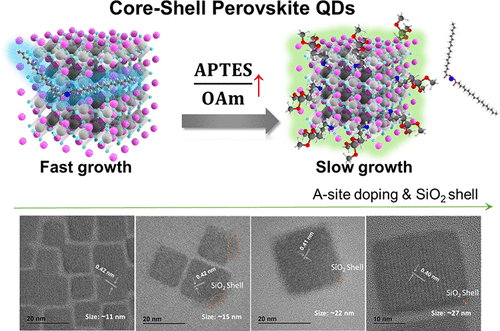当前位置:
X-MOL 学术
›
ACS Appl. Mater. Interfaces
›
论文详情
Our official English website, www.x-mol.net, welcomes your
feedback! (Note: you will need to create a separate account there.)
Synthesis of Chemically Stable Ultrathin SiO2-Coated Core–Shell Perovskite QDs via Modulation of Ligand Binding Energy for All-Solution-Processed Light-Emitting Diodes
ACS Applied Materials & Interfaces ( IF 8.3 ) Pub Date : 2021-06-09 , DOI: 10.1021/acsami.1c06097 Cuc Kim Trinh 1 , Hanleem Lee 1 , Mo Geun So 1 , Chang-Lyoul Lee 1
ACS Applied Materials & Interfaces ( IF 8.3 ) Pub Date : 2021-06-09 , DOI: 10.1021/acsami.1c06097 Cuc Kim Trinh 1 , Hanleem Lee 1 , Mo Geun So 1 , Chang-Lyoul Lee 1
Affiliation

|
Recently, perovskite quantum dots (QDs) have attracted intensive interest due to their outstanding optical properties, but their extremely poor chemical stability hinders the development of the high-performance perovskite QD-based light-emitting diodes (PeLEDs). In this study, chemically stable SiO2-coated core–shell perovskite QDs are prepared to fabricate all-solution-processed PeLEDs. When the SiO2 shell thickness increases, the chemical stability of perovskite QDs is dramatically improved, while the charge injection efficiency is significantly decreased, which becomes the biggest obstacle for PeLED applications. Thus, controlling the SiO2 thickness is essential to obtain core–shell perovskite QDs optimal for PeLEDs in an aspect of chemical and optoelectrical properties. The 3-aminopropyl-triethoxysilane (APTES)/oleylamine (OAm) volume ratio is found to be a critical factor for obtaining an ultrathin SiO2 shell. Optimization of the APTES/OAm ratio affords A-site-doped CsPbBr3 QDs with an ultrathin SiO2 shell (A-CsPbBr3@SiO2 QDs) that exhibit longer radiative lifetimes and smaller shallow trap fraction than those without A-site doping, resulting in a higher photoluminescence quantum yield. A-CsPbBr3@SiO2 QDs also demonstrate long-term superior chemical stability in polar solvents without loss of optical properties due to passivation by the SiO2 shell and less defects via A-site doping. Consequently, all-solution-processed PeLED is successfully fabricated under ambient conditions, facilitating perovskite QD utilization in low-cost, large-area, flexible next-generation displays.
中文翻译:

通过调节配体结合能合成化学稳定的超薄 SiO 2包覆核壳钙钛矿量子点,用于全溶液处理的发光二极管
近年来,钙钛矿量子点(QDs)因其出色的光学性能而引起了广泛的关注,但其极差的化学稳定性阻碍了高性能钙钛矿量子点发光二极管(PeLEDs)的发展。在这项研究中,化学稳定的 SiO 2涂层核壳钙钛矿 QD 被制备用于制造全溶液处理的 PeLED。当SiO 2壳层厚度增加时,钙钛矿量子点的化学稳定性显着提高,而电荷注入效率显着降低,成为PeLED应用的最大障碍。因此,控制 SiO 2在化学和光电特性方面,厚度对于获得最适合 PeLED 的核壳钙钛矿 QD 至关重要。发现 3-氨基丙基-三乙氧基硅烷 (APTES)/油胺 (OAm) 的体积比是获得超薄 SiO 2壳的关键因素。APTES/OAm 比率的优化提供了具有超薄 SiO 2壳的A 位掺杂 CsPbBr 3 QD (A-CsPbBr 3 @SiO 2 QD),与没有 A 位掺杂的那些相比,具有更长的辐射寿命和更小的浅陷阱分数,导致更高的光致发光量子产率。A-CsPbBr 3 @SiO 2QD 还在极性溶剂中表现出长期优异的化学稳定性,而不会由于 SiO 2壳的钝化和 A 位掺杂导致的缺陷减少而损失光学性能。因此,全溶液处理的 PeLED 在环境条件下成功制造,促进了钙钛矿 QD 在低成本、大面积、柔性下一代显示器中的利用。
更新日期:2021-06-30
中文翻译:

通过调节配体结合能合成化学稳定的超薄 SiO 2包覆核壳钙钛矿量子点,用于全溶液处理的发光二极管
近年来,钙钛矿量子点(QDs)因其出色的光学性能而引起了广泛的关注,但其极差的化学稳定性阻碍了高性能钙钛矿量子点发光二极管(PeLEDs)的发展。在这项研究中,化学稳定的 SiO 2涂层核壳钙钛矿 QD 被制备用于制造全溶液处理的 PeLED。当SiO 2壳层厚度增加时,钙钛矿量子点的化学稳定性显着提高,而电荷注入效率显着降低,成为PeLED应用的最大障碍。因此,控制 SiO 2在化学和光电特性方面,厚度对于获得最适合 PeLED 的核壳钙钛矿 QD 至关重要。发现 3-氨基丙基-三乙氧基硅烷 (APTES)/油胺 (OAm) 的体积比是获得超薄 SiO 2壳的关键因素。APTES/OAm 比率的优化提供了具有超薄 SiO 2壳的A 位掺杂 CsPbBr 3 QD (A-CsPbBr 3 @SiO 2 QD),与没有 A 位掺杂的那些相比,具有更长的辐射寿命和更小的浅陷阱分数,导致更高的光致发光量子产率。A-CsPbBr 3 @SiO 2QD 还在极性溶剂中表现出长期优异的化学稳定性,而不会由于 SiO 2壳的钝化和 A 位掺杂导致的缺陷减少而损失光学性能。因此,全溶液处理的 PeLED 在环境条件下成功制造,促进了钙钛矿 QD 在低成本、大面积、柔性下一代显示器中的利用。































 京公网安备 11010802027423号
京公网安备 11010802027423号